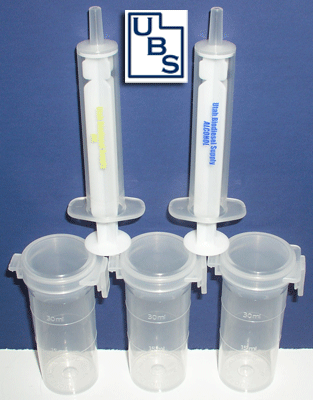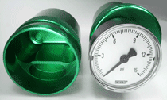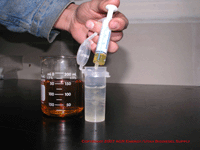Over the years, we’ve found that there are 3 key areas that anyone producing Biodiesel on a small scale should always follow to ensure great Biodiesel. If you’ve ever called in to Utah Biodiesel Supply for help, you’ve probably heard a few of these. So with that, here’s our three tips for ensuring you get great Biodiesel.
Tip #1 – Test For And Remove Water From The Oil Before Reacting
Tip #2 – Perform A 3/27 Conversion Test BEFORE Washing
Tip #3 – Test For Soap Levels In Washed Biodiesel
Tip#1 – Test For And Remove Water From The Oil Before Reacting
Judging by the number of phone calls & emails we get on this issue, I’d say that about 90% of the problems people have with making Biodiesel can be traced back to having too much water in the oil. Water is just a royal killer when it comes to Biodiesel reactions. If you have too much, it just causes all sorts of problems.
Here’s why…
Water + Oil + Catalyst = Soap (not Biodiesel)
Water + Oil + Methanol = A Big Mess (Again, not Biodiesel)
Water + Oil + Catalyst + Methanol = Soap + some Biodiesel + Glycerin
That pesky H20 just causes havoc like no other. The Methanol & Catalyst used in Biodiesel production like water a lot more than they like oil and they readily bond to the water instead of doing the job you WANT them to do (you know, making Biodiesel). It’s like luring kids away from doing their work by using candy. They’ll go for the candy over doing real work every time.
So, here’s how to deal with it.
First, identify how much water you have in your oil feedstock using one of these three methods. Then, use one of our methods described to get rid of as much of it as you can.
Here’s how to see if you have water in the oil
Hot Pan Test
The simplest test and most commonly used among Biodiesel enthusiasts is the hot pan test. This test is performed by heating up a pan and then dropping in a sample of the oil you plan on using & watching for bubbles.
Click here to see a video showing how it’s done.
Quantitative Water Test
This method requires extremely accurate scales, a notepad, a sample of oil, and a heat source (a microwave works great!) You measure the weight of your sample, then heat the crap out of it (to presumably boil off the water), and then weigh it again. The difference between the weights will tell you how much water is in your oil.
Click here to see a detailed description on how to perform this test
This method has become increasingly popular among Biodiesel enthusiasts, commercial Biodiesel producers, and and those running straight vegetable oil conversions. It involves adding a sample of water to a Deluxe Water Test Kit, shaking it, taking a quick reading and converting it into a total water percentage. Quick, simple, and easy.
Click here to see a video of how this test works
If any of these tests indicate water then it’s time for water removal. If using the Deluxe Water Test Kit, your goal is to have oil that has less than 0.15% water content in it before producing Biodiesel. That’s 1,500 Parts Per Million (PPM).
If you find you have water in your oil, here’s how to get it out.
Good Old Heat & Time
Heat and time are somewhat inverses of each other. The more heat you use, the less time it’s going to take to remove the water…and, consequently, the less heat you have, the more time it’s going to take.
In general, heat your oil to at least 100 deg. F or higher. If you can, take it up past the boiling point of water (212 deg. F) for an extended period of time or until you don’t see any more bubbles. A word of caution here, if you’re doing this in a 55 gallon drum or larger, be sure to STIR the oil while it’s heating. Oil’s pretty heavy and it’s possible for water to develop a pocket of steam down in the bottom of the tank. If that steam finally makes it’s way to the top on its own, it can cause some pretty nasty results (splattering, spewing, shooting fountains of oil, you get the picture), so stirring will help.
If you don’t plan on boiling all the water out, be sure you have a method for removing the water that has fallen to the bottom of the vessel (as oil heats up, water will fall to the bottom). Otherwise, once you mix the oil, you’re back to where you started.
Bubbling, Fans, & Circulating
Many people have also found success by bubbling air through the oil with a bubbler using an air pump or an air compressor.
Another very effective method is to use a spraying nozzle, circulating pump, and a fan to spray the biodiesel lightly back onto itself. The fan is blown over top of the vessel to create a low air pressure causing any water that evaporates to get sucked up & out of the barrel.
This method is incredibly effective because the moisture evaporates out of the oil fairly quickly.
Click here to see a bubbling setup
Click here to see a drying nozzle
Click here to see a drying setup in action
Interestingly enough, both of these methods will also work for drying Biodiesel after it’s been water washed too!
Tip #2 – Perform A 3/27 Conversion Test BEFORE Washing
This test is extremely simple to do and extremely effective. It works on the principle that fully converted Biodiesel will dissolve in methanol and won’t “fall out” of suspension.
Supplies Needed:
You’ll need some syringes, a vial, some methanol, and a sample of your finished Biodiesel.

Here’s how to do this test:
Add 3 mL of Biodiesel to 27 mL of Methanol
Shake and let it settle for 5 minutes
Look for fall out.
The methanol and Biodiesel both need to be between 68-72 Deg F for the test to be accurate, but it really is that simple.
If your Biodiesel fails to pass this test, then something didn’t go quite right in the reaction. In most cases, you can re-react the fuel by adding 30% of the methanol & catalyst used initially react it and then retest the fuel. There’s many reasons why Biodiesel may not have fully reacted, but until you pass this test, we really don’t recommend washing it. It’s just asking for problems.
We stock a handy kit with everything needed to perform this test To see the kit we offer, which includes
To see the kit we offer, which includes
2 syringes and 3 vials, click here
For details on how & why it works, click here
For step by step instructions, click here
For a video on performing the test, click here
To read more about the test, click here
We test every batch of Biodiesel we make using this test and view it as one of the necessary tests everyone should be doing every time they make a batch. The information it gives you is so valuable and the test is so easy to do that you really ought to consider adding it to your Biodiesel production regimen.
Tip #3 – Test For Soap Levels In Washed Biodiesel
The last test we recommend is to test for soap content. When Biodiesel is produced a fair amount of soap gets produced right along with it, no matter how dry the oil is. It’s just part of the process that goes with the territory.
A good Biodiesel production routine will include steps to thoroughly remove the soap from the Biodiesel. This can be through the use of water washing, dry washing, or even evaporating all the methanol out of the fuel and letting it stand for several days to allow the soaps to fall out of suspension.
Regardless of the method you employ, it’s important to make sure all of the soap is out before the fuel is used. Below are two simple ways that you can easily test for soap.
“Shake-Em Up” Test
We’re not really sure where this test originated, but it’s an extremely quick & powerful test that will give you an idea if the bulk amount of soap has been removed from your fuel. It’s not a perfect test in that it doesn’t indicate small amounts of soap still suspended in the Biodiesel, but it does give you a good idea if you’re “getting there” in your soap removal process.
Here’s how to do the test:
Fill a glass container half-way full of Biodiesel
Fill the rest with water
Screw the lid on and shake the daylights out of it
Set the jar down and allow it to settle for at least 30 minutes

If the water on the bottom is clear, the bulk of the soap has been removed from the Biodiesel. Don’t worry about the color or cloudiness of the Biodiesel above the water, that doesn’t matter for this test; all we’re after here is just clear water on the bottom.
Click here and scroll down for more details on how to perform this test.
We recommend performing the Shake-Em Up Test as a quick “gut check” test to see how your washing is coming along. It does have its faults though, one being that it’s somewhat sensitive to temperature and that not all soap is visible with the naked eye (in other words, the water may look crystal clear but there can still be soap in there).
To identify just how much soap really is in your Biodiesel, the test below is what you want to use.
Soap Titration Test
To do this test, you’ll need:
100 mL 99% Pure Isopropyl Alcohol
10 mL of Biodiesel to be tested
Bromophenol Blue
0.01 Normal Hydrochloric Acid
Syringes, beaker, and magnetic stirrer
Here’s how the test works.
A. Dissolve 10 mL Biodiesel Sample into 100 mL Isopropyl Alcohol
B. Add 10-20 drops of Bromophenol Blue to sample
C. Add Hydrochloric Acid to mixture until it turns yellow
D. Record how much acid you used
E. Calculate the soap levels present using the following formula
(mL Acid Used x 304) = Parts Per Million Soap in Biodiesel Sample
Click here to see our instructional video on how to do this test
If the soap levels are higher than 60 ppm, keep washing!
We sell this kit on our website. Click here to see it.
The corresponding ASTM soap levels are:
For KOH based Biodiesel, soap should not exceed 44 PPM
For NaOH based Biodiesel, soap should not exceed 65 ppm
Click here to read more about these specifications
And there you have it! Our 3 most common tests we recommend when making Biodiesel. There are obviously several more tests you can perform, but we’ve found that if you can pass all three of these tests, you’re bound to get really good Biodiesel.
Additional Resources:
If you’d like to learn more about making Biodiesel, visit these great websites:
Make-Biodiesel.org – Great educational site with lots of information
Collaborative Biodiesel Tutorial – Excellent resource packed with helpful tips
Getting Started Guide – Our Getting Started guide at Utah Biodiesel Supply





